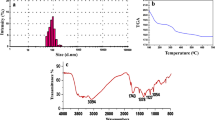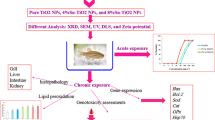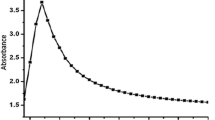Abstract
The incorporation of nanoparticles in industrial and biomedical applications has increased significantly in recent years, yet their hazardous and toxic effects have not been studied extensively. While standard toxicological test methods are generally capable of detecting the toxic effects, the choice of relevant methods for nanomaterials is still discussed. Among the various oxide nanomaterials, silica nanoparticles are widely used in biological applications that include nano-medicine. But studies on adverse effects of silica nanoparticle exposure to fish remain unclear. Therefore, the present study was designed to investigate the oxidative toxic effects of silicon dioxide nanoparticles using fish model. The size of the SiO2 nanoparticles was between 68 and 100 nm which was confirmed by X-ray diffractometer, dynamic light scattering, scanning electron microscope and transmission electron microscope. The zebra fish were exposed to sub-lethal concentrations (5 and 2.5 mg/L) of characterized SiO2 nanoparticles for a period of 7 days. After 7 days, SiO2 nanoparticle-treated fishes were sacrificed, and tissues such as liver, muscle and gill were dissected out for the analysis of antioxidant enzymes and DNA fragmentation. The DNA profiles were analysed in the tissues of zebra fish that treated with SiO2 nanoparticles. Tissues of fish from clean water were used as control, and DNA profiles were analysed. It is found that DNA from control tissues was intact, whereas the tissues treated with SiO2 were all fragmented. SiO2 nanoparticle-mediated antioxidant enzymes activities, such as catalase, superoxide dismutase, glutathione (GSH)-S-transferase, glutathione reductase and GSH, in the tissues of zebra fish were measured. The results revealed that alteration of antioxidant enzymes due to SiO2 nanoparticle can be considered as a biomarker to SiO2-mediated oxidative stress in biological samples.







Similar content being viewed by others
References
Ahamed, M., AlSalhi, M. S., & Siddiqui, M. K. J. (2010). Silver nanoparticle applications and human health. Clinica Chimica Acta, 411, 1841–1848.
Ahamed, M., Akhtar, M. J., Raja, M., Ahmad, I., Siddiqui, M. K. J., AlSalhi, M. S., et al. (2011). ZnO nanorod-induced apoptosis in human alveolar adenocarcinoma cells via p53, survivin and bax/bcl-2 pathways: role of oxidative stress. Nanomedicine, 7, 904–913.
Asharani, P. V., Mun, G. K., Hande, M. P., & Valiyaveettil, S. (2009). Cytotoxicity and genotoxicity of silver nanoparticles in human cells. ACS Nano, 3, 279–290.
Balbus, J. M., Maynard, A. D., Colvin, V. L., Castranova, V., Daston, G. P., & Denison, R. A. (2007). Meeting report: hazard assessment for nanoparticles—report from an interdisciplinary workshop. Environmental Health Perspectives, 115, 1654–1659.
Bellomo, G., Mirabelli, F., DiMonte, D., Richelmi, P., Thor, H., Orrenius, C., et al. (1987). Formation and reduction of glutathione—protein mixed disulfides during oxidative stress. A study with isolated hepatocytes and menadione (2-methyl-1, 4 naphthoquinone). Biochemical Pharmacology, 36, 1313–1320.
Culcasi, M., Benameur, L., Mercier, A., Lucchesi, C., Rahmouni, H., Asteian, A., et al. (2012). EPR spin trapping evaluation of ROS production in human fibroblasts exposed to cerium oxide nanoparticles: evidence for NADPH oxidase and mitochondrial stimulation. Chemico-Biological Interactions, 199(3):161–176.
Calibrone, A. L. (1985). Hand book of methods for oxygen radical research. Boca Raton: CRC. 283.
Chen, M., & Von, M. A. (2005). Formation of nucleoplasmic protein aggregates impairs nuclear function in response to SiO2 nanoparticles. Experimental Cell Research, 305, 51–62.
Chen, Z., Meng, H., Xing, G., Yuan, H., Zhao, F., Liu, R., et al. (2008). Age-related differences in pulmonary and cardiovascular responses to SiO2 nanoparticle inhalation: nanotoxicity has susceptible population. Environmental Science and Technology, 42, 8985–8992.
Ferre, M., Gajdaschranty, K., Kantiani, L., & Barcelo, D. (2009). Ecotoxicity and analysis of nanomaterials in the aquatic environment. Analytical and Bioanalytical Chemistry, 393, 81–95.
Fujita, K., Morimoto, Y., Ogami, A., Myoiyo, T., Tanaka, I., Shimada, M., et al. (2009). Gene expression profiles in rat lung after inhalation exposure to C60 fullerene particles. Toxicology, 258, 47–55.
Grassian, V. H., O'Shaughnessy, P. T., Adamcakova-Dodd, A., Pettibone, J. M., & Thorne, P. S. (2007). Inhalation exposure study of titanium dioxide nanoparticles with a primary particle size of 2 to 5 nm. Environmental Health Perspectives, 115, 397–402.
Habig, W. H., Pabst, M. J., & Jakoby, W. B. (1974). Glutathione S transferases. The first enzymatic step in mercapturic acid formation. The Journal of Biological Chemistry, 251, 7130–7139.
Halliwel, B., & Gutteridge, J. M. C. (1995). Free radicals in biology and medicine. New York: Oxford University Press.
Hansen, S. F., Maynard, A., Baun, A., & Tickner, J. A. (2008). Late lessons from early warnings for nanotechnology. Nature Nanotechnology, 3, 444–447.
Hauck, T. S., Ghazani, A. A., & Chan, W. C. W. (2008). Assessing the effect of surface chemistry on gold nanorod uptake, toxicity, and gene expression in mammalian cells. Small, 4, 153–159.
Huang, C. C., Aronstam, R. S., Chen, D. R., & Huang, Y. W. (2010). Oxidative stress, calcium homeostasis, and altered gene expression in human lung epithelial cells exposed to ZnO nanoparticles. Toxicol in Vitro, 24, 45–55.
Hussain, S., Boland, S., & Baeza-Squiban, A. (2009). Oxidative stress and proinflammatory effects of carbon black and titanium dioxide nanoparticles: role of particle surface area and internalized amount. Toxicology, 260, 142–149.
Jonathan, K. (2008). Nanotechnology boom expected by 2015. Industrial week. July 22
Kaewamatawong, T., Shimada, A., Okajima, M., Inoue, H., Morita, T., Inoue, K., et al. (2006). Acute and subacute pulmonary toxicity of low dose of ultrafine colloidal silica particles in mice after intratracheal instillation. Toxicologic Pathology, 34, 958–965.
Li, Y., Sun, L., Jin, M., Du, Z., Liu, X., & Guo, C. (2011). Size-dependent cytotoxicity of amorphous silica nanoparticles in human hepatoma HepG2 cells. Toxicology In Vitro, 25(7), 1343–1352.
Limbach, K., Wick, P., Manser, P., Grass, R. N., Bruinink, A., & Stark, W. J. (2007). Exposure of engineered nanoparticles to human lung epithelial cells: influence of chemical composition and catalytic activity on oxidative stress. Environmental Science and Technology, 41, 4158–4163.
Liu, T., Li, L., Teng, X., Huang, X., Liu, H., Chen, D., et al. (2011). Single and repeated dose toxicity of mesoporous hollow silica nanoparticles in intravenously exposed mice. Biomaterials, 32, 1657–1668.
Lowry, O. H., Rosebrough, N. J., Farr, A. L., & Randall, R. J. (1951). Protein measurement with the folin phenol reagent. The Journal of Biological Chemistry, 193, 265–275.
Lu, X., Tian, Y., Zhao, Q., Jin, T., Xiao, S., & Fan, X. (2011). Integrated metabonomics analysis of the size-response relationship of silica nanoparticles-induced toxicity in mice. Nanotechnology, 22, 16.
Marklund, S., & Marklund, G. (1974). Involvement of superoxide anion radical in the autooxidation of pyrogallol and a convenient assay for superoxide dismutase. European Journal of Biochemistry, 47, 469–474.
Moron, M. S., Depierre, J. W., & Mannervik, B. (1979). Levels of glutathione, glutathione reductase, and glutathione-S-transferase activities in rat lung and liver. Biochimica et Biophysica Acta, 82, 67–78.
Nanovip. (2010). Who’s regulating nanotechnology? Nanovip. April 23. http://www.nanovip.com/whos-regulating-nanotechnology.html.
Nishimori, H., Kondoh, M., Isoda, K., Tsunoda, S., Tsutsumi, Y., & Yagi, K. (2009). Silica nanoparticles as hepatotoxicants. European Journal of Pharmaceutics and Biopharmaceutics, 72, 496–501.
Oberdorster, E. (2004). Manufactured nanomaterials (fullerenes, C60) induce oxidative stress in the brain of juvenile largemouth bass. Environmental Health Perspectives, 112, 1058–1062.
Park, E. J., & Park, K. (2009). Oxidative stress, pro-inflammatory responses induced by silica nanoparticles in vivo and in vitro. Toxicology Letters, 184(1), 18–25.
Park, E. J., Choi, J., Park, Y., & Park, K. (2008). Oxidative stress induced by cerium oxide nanoparticles in cultured BEAS-2B cells. Toxicology, 1(2), 90–100.
Poland, C. A., Duffin, R., Kinloch, I., Maynard, A., Wallace, W. A. H., Seaton, A., et al. (2008). Carbon nanotubes introduced into the abdominal cavity of mice show asbestos-like pathogenicity in a pilot study. Nature Nanotechnology, 3, 423–428.
Sambrook, J., Fritsch, E. F., & Maniatis, T. (1989). Molecular cloning: a laboratory manual (2nd ed.). Cold Spring Harbor: Cold Spring Harbor Laboratory.
Shi, H., Hudson, L. G., & Liu, K. J. (2004). Oxidative stress and apoptosis in metal ion induced carcinogenesis. Free Radical Biology & Medicine, 37, 582–593.
Shvedova, A. A., Castranova, V., Kisin, E. R., Murray, A. R., Schwegler-Berry, D., Gandelsman, V. Z., et al. (2003). Exposure to carbon nanotube material: assessment of nanotube cytotoxicity using human keratinocyte cells. Journal of Toxicology and Environmental Health. Part A, 66, 1901–1918.
Singh, N., Manshian, B., & Jenkins, G. J. S. (2009). Nano genotoxicology: the DNA damaging potential of engineered nanomaterials. Biomaterials, 30(23–24), 3891–3914.
Stober, W., Fink, A., & Bohn, E. (1968). Controlled growth of monodisperse silica spheres in the micron size range. J Colloid Interface Sci, 26, 62–69.
Wise, J. P., Goodale, B. C., & Wise, S. S. (2010). Silver nanospheres are cytotoxic and genotoxic to fish cells. Aquatic Toxicology, 97, 34–41.
Xia, T., Kovochich, M., Liong, M., Madler, L., Gilbert, B., & Shi, H. (2008). Comparison of the mechanism of toxicity of zinc oxide and cerium oxide nanoparticles based on dissolution and oxidative stress properties. ACS Nano, 2, 2121–2134.
Xie, G., Sun, J., Zhong, G., Shi, L., & Zhang, D. (2010). Biodistribution and toxicity of intravenously administered silica nanoparticles in mice. Archives of Toxicology, 84, 183–190.
Yang, X., Liu, J., He, H., Zhou, L., Gong, C., Wang, X., et al. (2010). SiO2 nanoparticles induce cytotoxicity and protein expression alteration in HaCaT cells. Particle and Fibre Toxicology, 7, 1.
Yu, K. O., Grabinski, C. M., Schrand, A. M., Murdock, R. C., Wang, W., Gu, B., et al. (2009). Toxicity of amorphous silica nanoparticles in mouse keratinocytes. Journal of Nanoparticle Research, 11, 15–24.
Acknowledgments
Mr. R. Ramesh greatly acknowledges the University Grant commission (UGC), New Delhi for providing “UGC Research Fellowship in Sciences for Meritorious Students” (RFSMS) and the DST-FIST, UGC-SAP, UGC and MoE&F for the instrumentation facilities.
Author information
Authors and Affiliations
Corresponding author
Rights and permissions
About this article
Cite this article
Ramesh, R., Kavitha, P., Kanipandian, N. et al. Alteration of antioxidant enzymes and impairment of DNA in the SiO2 nanoparticles exposed zebra fish (Danio rerio). Environ Monit Assess 185, 5873–5881 (2013). https://doi.org/10.1007/s10661-012-2991-4
Received:
Accepted:
Published:
Issue Date:
DOI: https://doi.org/10.1007/s10661-012-2991-4




